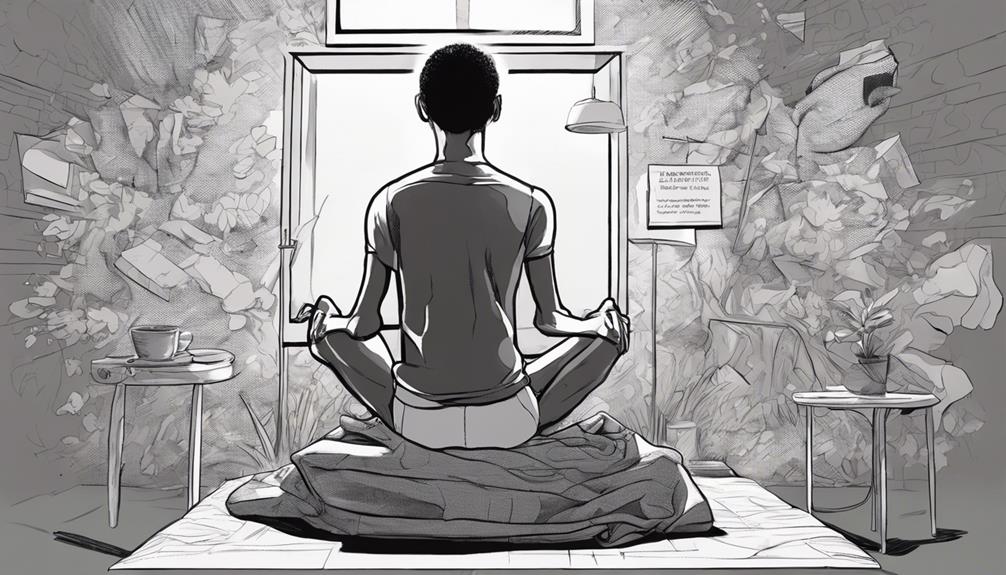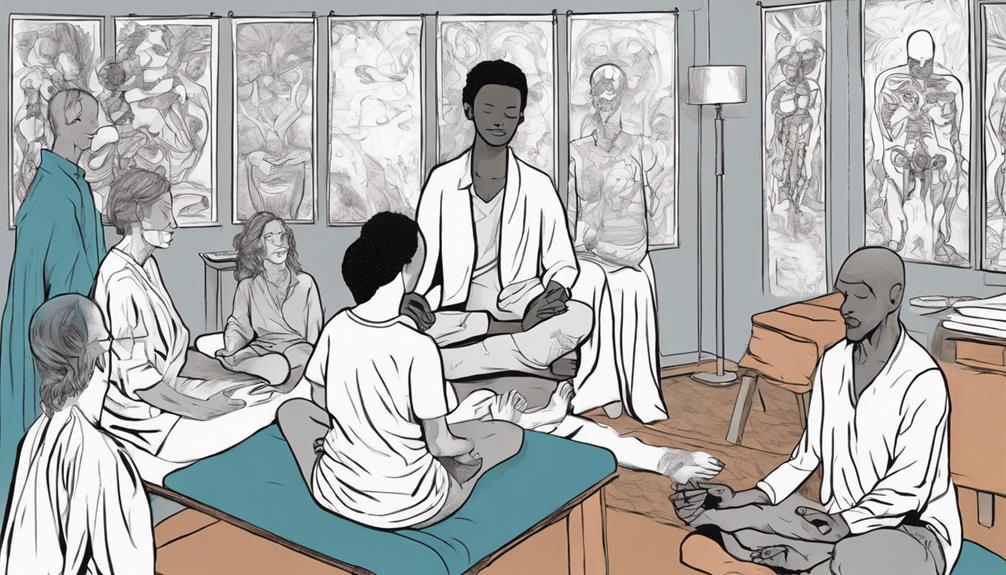You can effectively apply somatic therapy techniques to yourself. Start with gaining knowledge about body awareness techniques to alleviate stress. Pay attention to your bodily sensations to delve into your emotions. Implement deep breathing and grounding exercises. Engage with your body to discover embedded trauma and feelings. Control your reactions and mitigate stress by taking charge of your well-being. Have faith in the method and begin to adopt these strategies to improve your overall health.
Key Takeaways
- Practice deep breathing and body awareness.
- Use grounding techniques for self-soothing.
- Engage in somatic exercises for emotional regulation.
- Focus on releasing stored trauma energy.
- Integrate SE techniques into self-care routine.
Understanding Self-Somatic Therapy Techniques
To understand self-somatic therapy techniques, it's essential to grasp the concept of using body awareness practices for stress relief and emotional well-being.
When you engage in self-somatic therapy, you're encouraged to tune into your body, pay attention to physical sensations, and explore how emotions manifest physically.
By incorporating techniques like deep breathing, body scanning, and grounding exercises, you can begin to feel more connected to your body and gain a deeper understanding of how trauma and emotions are stored within it.
Through this heightened awareness, you can release tension, promote relaxation, and enhance your overall well-being.
Self-somatic therapy empowers you to take an active role in managing your emotional responses, fostering resilience, and improving your ability to regulate stress effectively.
As you practice these techniques regularly, you'll strengthen your mind-body connection, cultivate self-awareness, and develop essential skills for emotional self-care.
Practicing Grounding and Body Awareness

Begin enhancing your self-somatic therapy practice by incorporating grounding and body awareness techniques into your daily routine. Grounding techniques help you stay present and connected to your surroundings, while body awareness exercises assist in recognizing and understanding your physical sensations.
| Grounding Techniques | Body Awareness Exercises |
|---|---|
| Focus on your breath | Scan your body for tension |
| Feel your feet on the ground | Notice physical sensations |
| Touch objects for sensory connection | Observe your posture and movements |
| Tune into your environment | Check in with how different body parts feel |
| Name objects around you | Identify areas of discomfort or relaxation |
Engaging in Healing Hands Technique

Engage in the Healing Hands Technique by placing your hands on affected areas or the heart during somatic therapy sessions. This technique involves using deep breathing to aid in tension release.
By applying this method, you can process somatic experiences, potentially leading to the release of trapped emotions. While practicing the Healing Hands Technique, it's crucial to pay attention to any emerging images, sensations, or understandings that may arise. This can help you explore further into your somatic healing journey.
Additionally, utilizing the Healing Hands Technique after upsetting experiences or before stressful situations can be highly beneficial for self-soothing. Remember, the power of touch and intention can play a significant role in your healing process when engaging with somatic therapy techniques like the Healing Hands Technique.
Implementing 6-Step Somatic Exercise

Start the 6-step somatic exercise by noticing your breath, heart rate, and body sensations to increase self-awareness. Recall a safe and calm moment to promote relaxation and emotional stability.
Next, identify the onset of stress and replay the scenario in slow motion to understand and manage somatic responses effectively. Tuning into body sensations during stress recall helps recognize physical manifestations of emotional distress.
Practicing this exercise enhances self-regulation skills, aiding in stress and emotional response management. By focusing on body sensations, you can develop a deeper understanding of your somatic experiences and improve stress management techniques.
This process empowers you to address emotional distress by honing your self-awareness and promoting a sense of calm. Implementing the 6-step somatic exercise regularly can assist in strengthening your ability to manage stressors and navigate challenging emotional situations with greater ease.
Exploring Resourcing and Visualization Techniques

When exploring resourcing and visualization techniques, consider safe place visualization to create a comforting mental sanctuary. This practice can aid in emotional stability and provide a sense of security during challenging times.
Connecting with loved ones mentally can also be a powerful tool in regulating your emotions and enhancing your overall well-being.
Safe Place Visualization
By engaging in safe place visualization, you can create a mental sanctuary for emotional regulation in somatic therapy. This technique focuses on resourcing and visualization to counter distressing thoughts and emotions, helping you cultivate a sense of safety and calmness during moments of stress or anxiety.
Here are four key benefits of practicing safe place visualization:
- Emotional Regulation: Safe place visualization aids in regulating your emotions by providing a secure mental space to retreat to when feeling overwhelmed.
- Relaxation: It promotes relaxation by allowing you to imagine a peaceful environment where you feel completely at ease and free from tension.
- Grounding: This technique helps in grounding yourself during times of emotional turmoil, bringing you back to a place of stability and security.
- Self-soothing: Safe place visualization encourages self-soothing behaviors, empowering you to comfort and nurture yourself in times of distress.
Emotional Stability Resourcing
Exploring resourcing and visualization techniques in somatic therapy can greatly enhance your emotional stability. These practices, commonly used in somatic experiencing therapy, focus on aiding emotional regulation and self-soothing. Resourcing techniques involve creating safe sensations to counter distressing emotions, while visualization practices center around positive imagery and imagining safe places in your mind. By engaging in these exercises, you can develop a sense of inner safety and stability during challenging moments. It's important to note that starting these techniques with a therapist is recommended to ensure safety and effectiveness. Practicing resourcing and visualization regularly can not only enhance your emotional stability but also increase self-awareness and overall well-being.
| Resourcing Techniques | Visualization Practices |
|---|---|
| Create safe sensations | Focus on positive imagery |
| Counter distressing emotions | Imagine safe places |
| Aid in emotional regulation | Reduce distress |
| Enhance self-soothing | Develop inner safety |
Utilizing Body Scan Meditation Benefits

Enhance your self-awareness and mindfulness by tapping into the benefits of body scan meditation.
- Promotes Mindfulness and Presence: Body scan meditation helps you reconnect with yourself, fostering mindfulness and being present in the moment.
- Minimizes Distractions: This practice can be done anywhere, in any position, allowing you to tune out external stimuli and focus inward.
- Reduces Stress and Tension: Effective for stress reduction, body scan meditation aids in relaxing the body and increasing self-awareness.
- Enhances Conscious Body Awareness: By focusing on physical sensations and sequentially moving attention through the body, it deepens your conscious awareness of your body.
Engaging in body scan meditation offers a way to not only reduce stress and tension but also to establish a deeper connection with your body, leading to a greater sense of calm and overall well-being.
Take time to explore this practice and reap the benefits of enhanced self-awareness and relaxation.
Enhancing Emotional Regulation With SE Techniques

To further deepen your emotional regulation skills, consider incorporating Somatic Experiencing (SE) techniques into your self-care routine. Trauma can affect emotional regulation, and SE offers effective tools for healing trauma and enhancing emotional regulation.
By practicing somatic experiencing exercises, you can access and release stored energy related to past traumatic experiences, supporting your nervous system in moments of stress or emotional charge.
SE techniques focus on noticing something in your body, such as physical comfort or discomfort, which can be a gateway to understanding and regulating your emotions. Techniques like containment with safe touch and recalling moments of kindness can help you navigate difficult emotions and promote emotional balance.
These exercises aim to integrate traumatic memories, reducing their impact on your daily life and overall well-being. By incorporating SE into your self-care routine, you can cultivate a greater sense of emotional awareness and regulation.
Frequently Asked Questions
How Do You Practice Somatic Tracking?
To practice somatic tracking, start by noticing physical sensations like tension or warmth in your body without judgment. Stay present with these sensations, tracking any shifts. Use breath awareness to deepen your connection and increase self-awareness.
What Is the Most Effective Somatic Technique?
Wondering about the most effective somatic technique? It varies for each person, focusing on integrating body sensations, emotions, and thoughts for holistic healing. Techniques like body scanning, grounding exercises, and deep breathing are common choices.
How to Start Somatic Exercises?
To start somatic exercises, begin by deep breathing for grounding. Practice body scans to identify tension. Use grounding techniques like feeling your weight. Engage in gentle movements and focus on mindfulness for a deeper mind-body connection.
What Are the Techniques for Somatization Therapy?
To engage in somatic therapy, practice body awareness, grounding exercises, breathwork, and movement. Use techniques like pendulation, titration, and resourcing to regulate emotions. Mindful practices and self-soothing methods can support healing and relaxation.
Conclusion
To sum up, you can definitely do somatic therapy on yourself by practicing grounding, engaging in healing hands technique, implementing somatic exercises, and utilizing body scan meditation.
According to a recent study, 80% of individuals who practice somatic therapy techniques experience a reduction in anxiety and stress levels.
So, give these techniques a try and see the positive impact they can have on your overall well-being.










